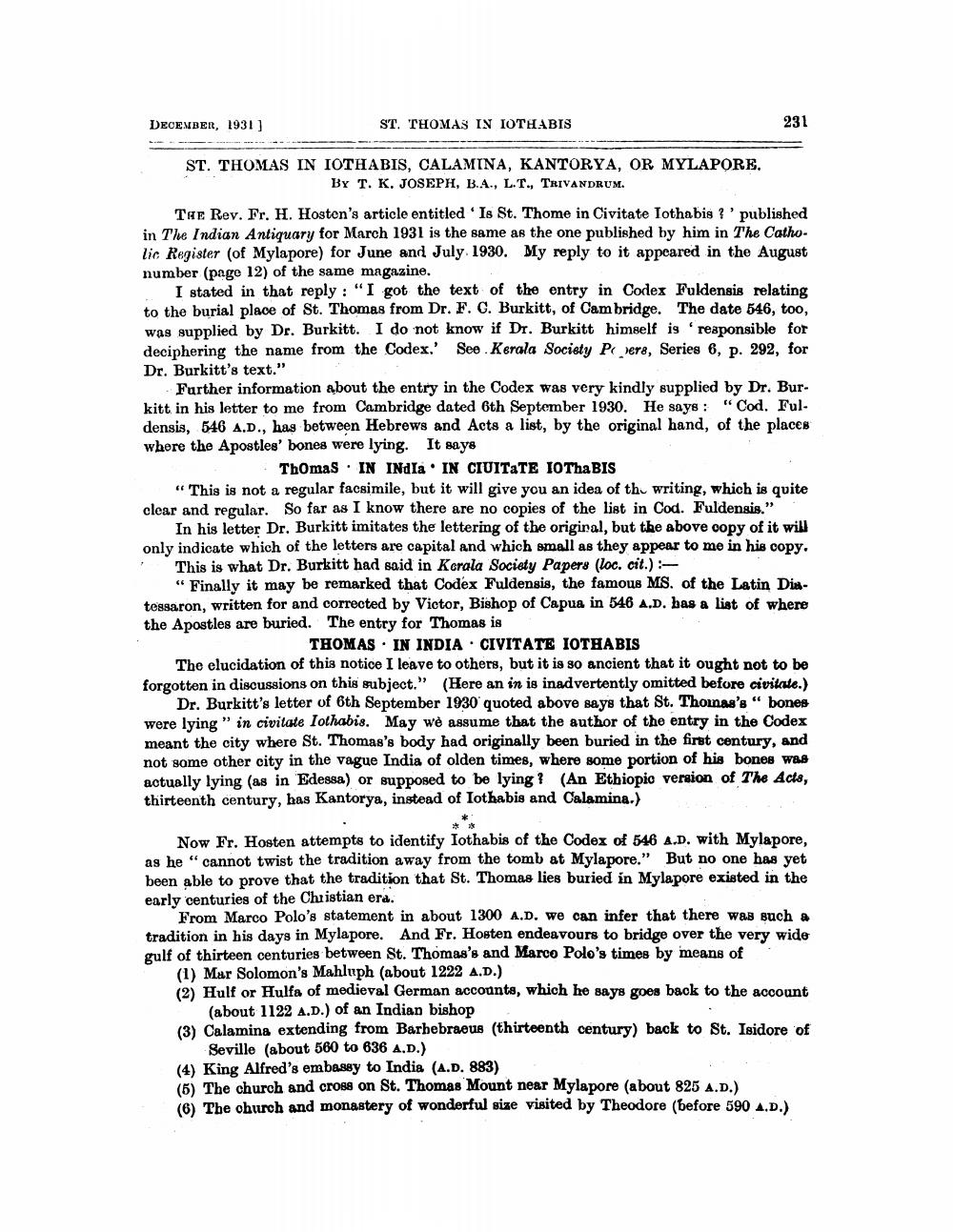________________
DECEMBER, 1931]
ST. THOMAS IN IOTHABIS
231
ST. THOMAS IN IOTHABIS, CALAMINA, KANTORYA, OR MYLAPORE.
BY T. K. JOSEPH, B.A., L.T., TRIVANDRUM.
TAE Rev. Fr. H. Hosten's article entitled 'Is St. Thome in Civitate lothabis ? ' published in The Indian Antiquary for March 1931 is the same as the one published by him in The Catholic Register (of Mylapore) for June and July 1930. My reply to it appeared in the August number (page 12) of the same magazine.
I stated in that reply: "I got the text of the entry in Codex Fuldensis relating to the burial place of St. Thomas from Dr. F. C. Burkitt, of Cambridge. The date 546, too, was supplied by Dr. Burkitt. I do not know if Dr. Burkitt himself is responsible for deciphering the name from the Codex.' See Kerala Society P ere, Series 6, p. 292. for Dr. Burkitt's text."
Further information about the entry in the Codex was very kindly supplied by Dr. Burkitt in his letter to me from Cambridge dated 6th September 1930. He saye : "Cod. Ful. densis, 546 A.D., has between Hebrews and Acts a list, by the original hand, of the places where the Apostles' bones were lying. It says
Thomas · IN INDIA IN CIUITATE 10ThaBIS "This is not a regular facsimile, but it will give you an idea of thu writing, which is quite clear and regular. So far as I know there are no copies of the list in Cod. Fuldensis."
In his letter Dr. Burkitt imitates the lettering of the original, but the above copy of it will only indicate which of the letters are capital and which small as they appear to me in his copy,
This is what Dr. Burkitt had said in Kerala Society Papers (loc. cit.)
"Finally it may be remarked that Codex Fuldensis, the famous MS. of the Latin Distessaron, written for and corrected by Victor, Bishop of Capua in 546 A.D. has a list of where the Apostles are buried. The entry for Thomas is
THOMAS. IN INDIA CIVITATE IOTHABIS The elucidation of this notice I leave to others, but it is so ancient that it ought not to be forgotten in discussions on this subject." (Here an in is inadvertently omitted before civitate.)
Dr. Burkitt's letter of 6th September 1930 quoted above says that St. Thomas's " bones were lying " in civitate lothabis. May we assume that the author of the entry in the Codex meant the city where St. Thomas's body had originally been buried in the first century, and not some other city in the vague India of olden times, where some portion of his bones was actually lying (as in Edessa) or supposed to be lying? (An Ethiopic version of The Acts, thirteenth century, has Kantorya, instead of Iothabis and Calamina.)
Now Fr. Hosten attempts to identify Iothabis of the Codex of 546 A.D. with Mylapore, as he “cannot twist the tradition away from the tomb at Mylapore." But no one has yet been able to prove that the tradition that St. Thomas lies buried in Mylapore existed in the early centuries of the Christian era.
From Marco Polo's statement in about 1300 A.D. we can infer that there was such a tradition in his days in Mylapore. And Fr. Hosten endeavours to bridge over the very wide gulf of thirteen centuries between St. Thomas's and Marco Polo's times by means of
(1) Mar Solomon's Mahluph (about 1222 A.D.) (2) Hulf or Hulfa of medieval German accounts, which he says goes back to the account
(about 1122 A.D.) of an Indian bishop (3) Calamina extending from Barhebraeus (thirteenth century) back to St. Isidore of
Seville (about 560 to 636 A.D.) (4) King Alfred's embassy to India (A.D. 883) (5) The church and cross on St. Thomas Mount near Mylapore (about 825 A.D.) (6) The church and monastery of wonderful size visited by Theodore (before 590 A.D.)




